

ALGIZ 10X improves order fulfillment at 150,000-square-meter warehouse
NAUTIZ X8 provides communication and navigation support for glacier explorer
Fast, discreet radiation monitoring — Inconspicuous NAUTIZ X8 makes it easy
Timber buyers increase accuracy, efficiency and profits with rugged handhelds
Algiz 10X emergency response system improves efficiency for ambulance workers
Nautiz X3 helps meat distribution company improve quality control in refrigerated storage facilities
Nautiz X8 helps GIS professionals calculate utility pole measurements
Great Lake Energy uses Algiz 7 computers used in SHESH project
Algiz 10X computers used in telemedicine case
Nautiz X4 computers improve logistics and cargo monitoring for a Scandinavian transport company
Handheld CEO: Rugged computers a game-changer in critical field rescue situations
Handheld CEO: Rugged Computing Key Trends in 2015
Handheld CEO: Rugged Computers Are More Than Just 'Hard Shells'
Handheld CEO: The Trend Towards 'Ruggedish' Computers and Smartphones
Technology for Technicians: 2013 Trends
Handheld CEO: How to Purchase Mobile Computers Wisely
Case Study: Computers in Diving and Marine Exploration
Handheld Group Business Partner Conference 2010, Stockholm
|

|

|
|
|
|
Case Study: Computers in Marine Exploration
Handheld Algiz RT10 rugged Android tablet computer 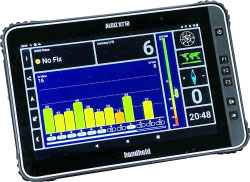 boosts productivity, data capture and positioning on all-female marine expedition beyond the arctic circle boosts productivity, data capture and positioning on all-female marine expedition beyond the arctic circle
(by Conrad H. Blickenstorfer -- photography by Carol Cotton)
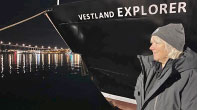 When you know that your work is going to be conducted under extreme conditions, you bring along equipment that is up to the job. Carol Cotton, RuggedPCReview.com's Director of Photography, found herself in such a position when she planned for a three week ocean research and snorkel expedition in the cold waters of upper Norway. When you know that your work is going to be conducted under extreme conditions, you bring along equipment that is up to the job. Carol Cotton, RuggedPCReview.com's Director of Photography, found herself in such a position when she planned for a three week ocean research and snorkel expedition in the cold waters of upper Norway.
Cotton was part of the all-female Sea Women Expeditions team that took place during the winter herring run in Norway's Arctic fjords, over 200 miles north of the Arctic Circle. The international team of 34 from well over a dozen nations departed Tromsø, Norway, November 16, 2022 aboard the polar research vessel MV Vestland Explorer for their three-week expedition, exploring interlocking themes of gender, ocean sustainability, loss of biodiversity and climate change in the Arctic.
This year, the herring run in Norway's Arctic fjords, over 200 miles north of the Arctic Circle, started early November. This gave the SWX team opportunity to snorkel with orcas, humpback whales and fin wales to collect observational behavioral data and collect critical biological and environmental data about the warming arctic environment. Cotton's job was to visually record and document the expedition and she chose to bring along a tough and rugged Handheld Algiz RT10 tablet computer as part of her gear.
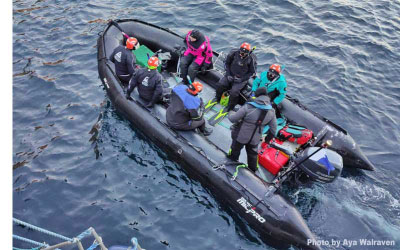 The expedition was conceived because the arctic ocean is warming and acidifying faster than any other oceanic body, causing a domino effect on marine and planetary ecosystems. "The oceans are the climate change engines of the planet," said Canadian geoscientist and expedition lead Susan R. Eaton. "By studying what's happening in arctic waters, we can better predict what may happen on a planetary level."
The expedition was conceived because the arctic ocean is warming and acidifying faster than any other oceanic body, causing a domino effect on marine and planetary ecosystems. "The oceans are the climate change engines of the planet," said Canadian geoscientist and expedition lead Susan R. Eaton. "By studying what's happening in arctic waters, we can better predict what may happen on a planetary level."
In terms of the marine mammals, behavioral studies also document interactions between snorkelers and orcas during the winter herring run. These can help shape policies for Norway's increasingly popular ecotourism — ensuring the long-term sustainability of these apex predator populations. To that extent, the expedition conducted acoustic recordings with multi-directional hydrophones to analyze unique orca dialects. "The impacts of snorkeling with free-ranging killer whales are understudied," said Sarah Neill, British marine biologist and SWX expedition co-leader. "There's a need to add to baseline data to document this snorkeling with orcas in order to better inform management policies and ensure the sustainability of these ecotourism ventures."

The pictures above and below, taken by Cotton with a GoPro Hero 11 Black action camera in its underwater housing, show a pod of orcas flashing by in the waters just south of Nord-Fugløya, an uninhabited island that's a nature preserve. Between the very limited daylight at that latitude (just over two hours between sunrise and sunset), water temperatures in the low 40Fs which meant wearing drysuits with extensive thermal protection, and the speed of the orca pods, capturing anything on video underwater was a challenge!

Computers in marine exploration
Computers have become an inextricable part of virtually every aspect of our personal as well as professional lives. It is almost unnecessary to mention that they play a crucial role in marine exploration as well. Just how much we rely on them is perhaps never more evident than when we find outselves in remote, challenging environments where nothing can be taken for granted. Environments like an expedition boat in arctic waters.
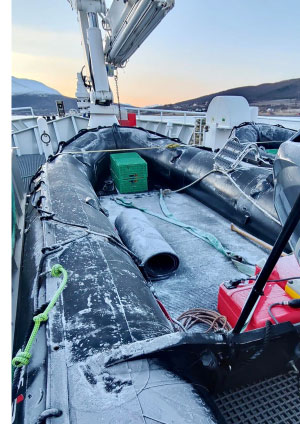 While the 150 foot passenger/cargo ship Vestland Explorer turned out to have remarkably spacious accommodations as well as creature comforts, it was still a ship in cold arctic waters in dark arctic winter with plenty of frost and, despite the Gulf Stream that makes for more temperate climate and waters than one would expect so far up in the north, temperatures mostly in teens and low 20s. While the 150 foot passenger/cargo ship Vestland Explorer turned out to have remarkably spacious accommodations as well as creature comforts, it was still a ship in cold arctic waters in dark arctic winter with plenty of frost and, despite the Gulf Stream that makes for more temperate climate and waters than one would expect so far up in the north, temperatures mostly in teens and low 20s.
Overall, any electronic equipment installed on a boat, large or small, must be waterproof, and especially so if the boat is in salt water. Anyone who has seen how quickly gear ages or gets corroded in such environments will appreciate that most such equipment is made of specially formulated stainless steel.
How about mobile computing gear and equipment used by expeditions? That, too, must be up to the challenge of hard use outdoors, be sealed against the elements, impervious to not just the inevitable bumps and grinds but also salt water, salt spray and salt fog. Then there's temperature. Not all equipment works well when it gets into the low teens.
Connectivity becomes an issue. Many systems today simply assume they're constantly connected and they won't work without. On high sea or in remote fjords signals are hard to come by. That's when being able to lock on to weak or erratic WWAN and WLAN signals becomes important. And when solid, reliable GNSS can assume center stage.
Then there's power and charging. Batteries generally don't like the cold, and so a charge may not last nearly as long as it would in more temperate climates. And when traveling you never know where and when you can charge your gear. And since today we all rely on such much gear, the simpler the better. Big, heavy, proprietary old-style power bricks are a pain when just a simple USB-C cable can do. On the road and, especially, on the water you never know what to expect in terms of power, outlets, rules, regulations, and competition for precious charging stations and opportunities.
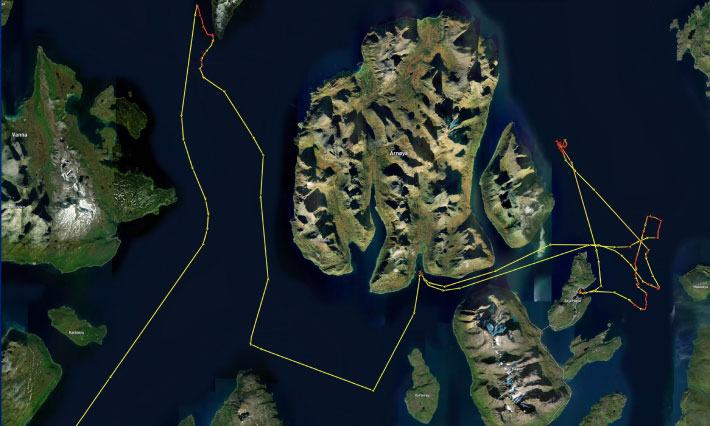
The above map shows the course of the Vestland Explorer vessel over the course of two or three days on the waters of Norwegian fjords. A typical day's journey depended on factors such temperature, water conditions, wind, current, anticipated cetacean sightings and more. 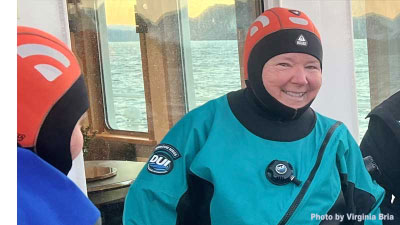
Each day the research vessel was underway for five to eight hours, travelling at a speed of almost ten knots, slowing down for whale or orca sightings, and stopping at promising locations to crane-lift the two zodiacs into the water.
Getting into the near freezing waters required professional quality drysuits with suitable undergarment layers as well as thick hoods and gloves.
Using the Handheld Algiz RT10 rugged tablet computer on the expedition vessel Vestland Explorer
Cotton didn't know how exactly she'd use the Algiz RT10 on the boat. Although the expedition had been planned for over two years, no one knew how it would be once the team was finally onboard. "One thing I found right away is the peace of mind that came from the Algiz RT10's ruggedness," said Cotton. "Using electronics on a boat in arctic waters is rough. It's cold, it's wet, it's slippery, and there's lots of gear and equipment you can and will bump into. It's no place for consumer laptops and tablets, but the Handheld Algiz RT10 fit right in."
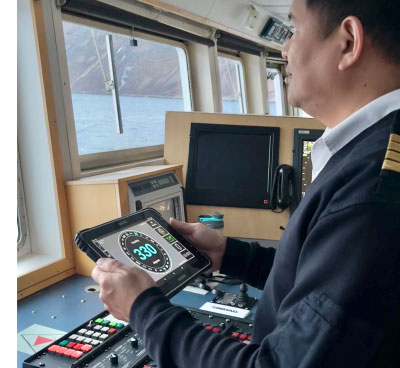 Using a computer on a boat means it needs a daylight-readable display. That goes even at above-arctic circle latitudes where daylight is short (the late November expedition saw the sun over the horizon for no more than an hour each day, and towards the end much less than that). The Algiz RT10's bright sunlight-readable high-res display is well suited for outdoor use and work. During her two weeks on the boat with the Sea Women expedition, Cotton encountered anything from nice sunshine to steely-gray skys and, of course, a good deal of wind and saltwater spray. The Algiz RT10 display easily handled all lighting conditions and was perfectly viewable at all time. Using a computer on a boat means it needs a daylight-readable display. That goes even at above-arctic circle latitudes where daylight is short (the late November expedition saw the sun over the horizon for no more than an hour each day, and towards the end much less than that). The Algiz RT10's bright sunlight-readable high-res display is well suited for outdoor use and work. During her two weeks on the boat with the Sea Women expedition, Cotton encountered anything from nice sunshine to steely-gray skys and, of course, a good deal of wind and saltwater spray. The Algiz RT10 display easily handled all lighting conditions and was perfectly viewable at all time.
While the decks on the Vestland Explorer offered some protection from the elements, it was still outdoors in the cold and in the midst of wet and dripping protective equipment, machinery, and fellow explorers. Being used on decks also included exposure to spray and the occasional splash over the tablet.
This is where the Algiz RT10's IP67 sealing came in handy. The "7" in the ingress protection rating means a device can survive being submerged in water, so water spray on an expedition boat, no matter how hard, certainly wouldn't hurt it. And unlike consumer tablets and smartphones, the RT10's capacitive multi-touch screen has special rain and glove modes for use outdoors and in bad weather. That takes a bit of getting used to, but it works.
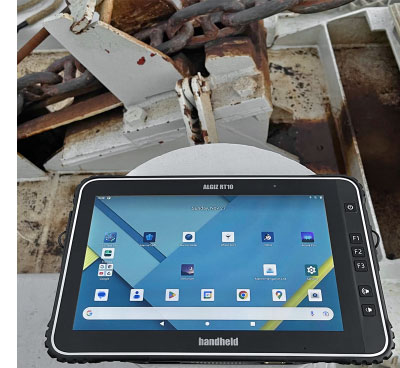 Space and weight are at a premium when one travels on planes and stays in small both cabins, and Cotton appreciated the Algiz RT10's compact size that easily made it fit into her gear. The Algiz RT10 was also light and compact enough not to add too much to the already considerable burden of all the gear and equipment needed for an extended maritime expedition. And, despite the cold, the Algiz RT10 got decent battery life. The 44.5 watt-hour externally accessible (if you have the right Torx screwdriver) and rechargeable battery was designed to last though an average full work-shift. On the boat it was generally good for several days of Cotton's workflow and the way she used the tablet. Space and weight are at a premium when one travels on planes and stays in small both cabins, and Cotton appreciated the Algiz RT10's compact size that easily made it fit into her gear. The Algiz RT10 was also light and compact enough not to add too much to the already considerable burden of all the gear and equipment needed for an extended maritime expedition. And, despite the cold, the Algiz RT10 got decent battery life. The 44.5 watt-hour externally accessible (if you have the right Torx screwdriver) and rechargeable battery was designed to last though an average full work-shift. On the boat it was generally good for several days of Cotton's workflow and the way she used the tablet.
Overall, using the Algiz RT10 as an expedition support computer made a number of tasks easier, said Cotton. Team members were collecting data, performing measurements, and spent much time on the zodiacs and in the water shooting pictures and video whenever the weather permitted. These days, much of that is done with small waterproof action cameras that rival imaging quality of much larger equipment while being much handier. But their displays are tiny and it's hard to even screen the footage of a swim or a day. Cotton always uploaded her image data from her GoPros to systems with bigger screens as soon as she was out of the water and back in her cabin.
Simply plugging the GoPros into the Android-based Algiz RT10 and dragging the files over made that easy. This allowed her to examine the footage of a session on a large display, keeping good video and shots, ditching the bad, and filing everything into folders by date and location. She also jotted down observations and thoughts when they were still fresh in her mind, and recorded video of herself stating her impressions and findings of the day.
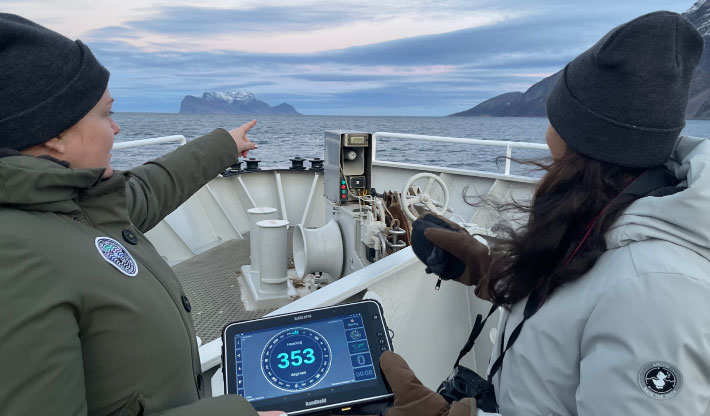
For tasks other than image examination, editing and storage, Cotton had preloaded the Algiz RT10 with a variety of apps that might come in handy. The expedition's travels several hundred kilometers north of the arctic circle offered hope for viewing of the aurora borealis, commonly known as northern lights. These are disturbances of the earth's magnetosphere caused by solar winds in a process not unlike lightning, and display as breathtaking ever-changing patterns of brilliant and green (and sometimes yellow, red and orange) lights in sky. There are apps that predict the probability level, time and intensity of aurora borealis sightings for any given point, and Cotton used such an app on the Algiz RT10, with spectacular results.
Cotton and another team member also greatly benefitted from an aurora borealis class and field tour by French astrophotographer and cinematographer Adrien Mauduit (see his website).
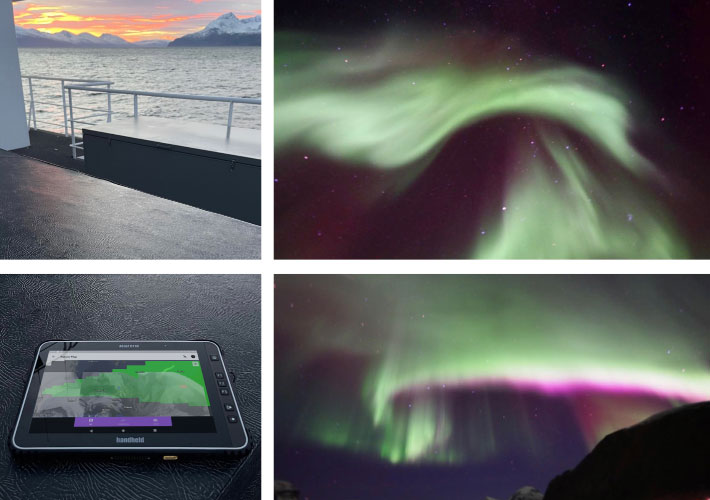
Another application of interest was the Stellarium Mobile star map that shows exactly what you see when you look up at the stars, and up in the fjords of northern Norway you can see A LOT of stars. The app helps identify stars, constellations, planets, and that directly related to one of the many presentations on the boat by Christine Keating on the Sámi people indigenous to the region of Sápmi, which was formerly known as Lapland. For the Sámi people, the sky is a mirror for how they live and view the world, and up on deck the Algiz RT10 helped tracking some of the Sámi constellations.
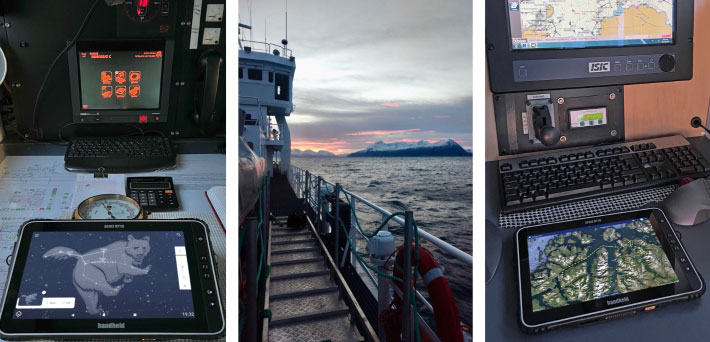
As it turned out, perhaps the most useful and most helpful application running on the Algiz RT10 was MarineTraffic, which allows tracking of any vessel in considerable detail. The value of that quickly became apparent. While on the water steaming up and down fjords, looping around islands, exploring bays and venturing out into the Norwegian Sea, it is almost impossible to track where you are, where you are going, and where you have been. The real-time maps available through MarineTraffic showed exactly where the research vessel had been, where it stopped or slowed down, where it anchored, and also what vessels (and even what types of vessels) were around it. This greatly helped the expedition to not only know where they had been and to document progress, but also match images and videos, as well as memories, to locations.
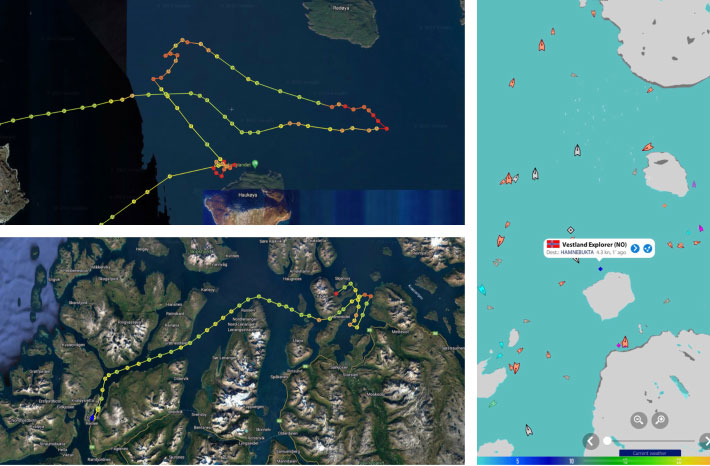
Last but not least, Cotton used the Algiz RT10's integrated camera. It did, of course, not replace the GoPros and other specialized photography and videography equipment, but its 5mp and 13mp cameras proved quite capable of taking a wide range of images, from casual snapshots on deck all the way to the nighttime panorama below. Impressive.

– Conrad H. Blickenstorfer, December 2022
FOR MORE INFO:
Sea Women Expeditions web
Sea Women Expeditions Facebook
Sea Women Expeditions Instagram
Handheld Group
Handheld Algiz RT10 product page
|
Handheld Group Algiz RT10 Specifications
|
| Status |
Added 12/2022
|
| Type |
Rugged Android tablet
|
| Processor |
Octa-core Qualcomm Snapdragon 480 SM4350 |
| Processor speed |
2.00GHz |
| OS |
Android 11 (GMS)
|
| Graphics |
Adreno 619 |
| Memory |
6GB |
| Display type |
Sunlight-readable TFT LCD with hardened glass |
| Display resolution |
10.0" (1920 x 1200 pixel, 16:10 aspect ratio) 226 ppi, 600 nits, 582 nits as tested |
| Digitizer/Pens |
10-point capacitive multi-touch (incl. rain and glove modes)
|
| Buttons |
Power, F1, F2, F3, volume up/down |
| Storage |
128GB |
| Expansion |
1 x Micro SDXC, 2 x Nano SIM |
| Housing |
Polymer plastic with protective rubber bumpers |
| Operating temperature |
-4 to 140 degrees Fahrenheit (-20 to 60 degrees centigrade) |
| Drops/shock |
26 drops from 1.2 m (4 ft) MIL-STD-810G, Method 516.6 Procedures IV
|
| Vibration |
MIL-STD-810G, Method 514.6 Procedure I
|
| Enclosure Class |
IP67, MIL-STD-810G, IEC 60529 |
| Altitude |
4572 m (15.000 ft)
MIL-STD-810G, Method 500.5 Procedures I & II |
| EMC/EMI |
MIL-STD-461F: CE101, CE102, CS101, CS114, CS115, CS116, RE101, RE102, RS101, RS103 |
| Hazardous materials |
unknown |
| Size |
10.8 x 7.3 x 0.67 inches (274 x 185 x 17 mm) |
| Weight |
2.2 pounds (980 grams)
|
| Power |
User-accessible, field-replaceable 3.8V 11,700mAh 44.46 watt-hour Li-Ion battery
|
| Camera |
5.0 MP (front), 13.0 MP with LED flash (rear)
|
| Sensors |
Ambient light, accelerometer, gyro, fingerprint
|
| Communication |
802.11a/b/g/n/ac, Bluetooth v5.1, integrated u-blox NEO M8U GNSS (GPS, GLONASS, Galileo, BeiDou, QZSS, SBAS), NFC, UHF RFID, 4G LTE, 5G (N41, N78, N79)
|
| Interface |
1 x Qualcomm QuickCharge USB Type-C OTG, 2 x USB 3.0 Type-A, 1 x 3.5mm audio in/out, power, docking connector (supporting HDMI, Ethernet, USB ?????), expansion connector in back
|
| Price |
Starting at US$1,499
|
| Spec sheet |
 Algiz RT10 product brochure (PDF) Algiz RT10 product brochure (PDF) |
| Web page |
Handheld Group Algiz RT10 product page |
| Contact |
Handheld Group AB
Strandgatan 40
531 60 Lidköping, Sweden
Tel: +46 (0) 510 54 71 70
Web: www.handheldgroup.com
Email: info @ handheldgroup.com
HHCS Handheld USA Inc.
2121 NE Jack London Street Suite 100
Corvallis, OR 97330, USA
Tel: (541) 752-0313
Web: www.handheld-us.com
Email: info @ handheld-us.com
|
(copyright 2022 RuggedPCReview.com)
|
|
|




 boosts productivity, data capture and positioning on all-female marine expedition beyond the arctic circle
boosts productivity, data capture and positioning on all-female marine expedition beyond the arctic circle
 When you know that your work is going to be conducted under extreme conditions, you bring along equipment that is up to the job. Carol Cotton, RuggedPCReview.com's Director of Photography, found herself in such a position when she planned for a three week ocean research and snorkel expedition in the cold waters of upper Norway.
When you know that your work is going to be conducted under extreme conditions, you bring along equipment that is up to the job. Carol Cotton, RuggedPCReview.com's Director of Photography, found herself in such a position when she planned for a three week ocean research and snorkel expedition in the cold waters of upper Norway.
 The expedition was conceived because the arctic ocean is warming and acidifying faster than any other oceanic body, causing a domino effect on marine and planetary ecosystems. "The oceans are the climate change engines of the planet," said Canadian geoscientist and expedition lead Susan R. Eaton. "By studying what's happening in arctic waters, we can better predict what may happen on a planetary level."
The expedition was conceived because the arctic ocean is warming and acidifying faster than any other oceanic body, causing a domino effect on marine and planetary ecosystems. "The oceans are the climate change engines of the planet," said Canadian geoscientist and expedition lead Susan R. Eaton. "By studying what's happening in arctic waters, we can better predict what may happen on a planetary level."


 While the 150 foot passenger/cargo ship Vestland Explorer turned out to have remarkably spacious accommodations as well as creature comforts, it was still a ship in cold arctic waters in dark arctic winter with plenty of frost and, despite the Gulf Stream that makes for more temperate climate and waters than one would expect so far up in the north, temperatures mostly in teens and low 20s.
While the 150 foot passenger/cargo ship Vestland Explorer turned out to have remarkably spacious accommodations as well as creature comforts, it was still a ship in cold arctic waters in dark arctic winter with plenty of frost and, despite the Gulf Stream that makes for more temperate climate and waters than one would expect so far up in the north, temperatures mostly in teens and low 20s.


 Using a computer on a boat means it needs a daylight-readable display. That goes even at above-arctic circle latitudes where daylight is short (the late November expedition saw the sun over the horizon for no more than an hour each day, and towards the end much less than that). The Algiz RT10's bright sunlight-readable high-res display is well suited for outdoor use and work. During her two weeks on the boat with the Sea Women expedition, Cotton encountered anything from nice sunshine to steely-gray skys and, of course, a good deal of wind and saltwater spray. The Algiz RT10 display easily handled all lighting conditions and was perfectly viewable at all time.
Using a computer on a boat means it needs a daylight-readable display. That goes even at above-arctic circle latitudes where daylight is short (the late November expedition saw the sun over the horizon for no more than an hour each day, and towards the end much less than that). The Algiz RT10's bright sunlight-readable high-res display is well suited for outdoor use and work. During her two weeks on the boat with the Sea Women expedition, Cotton encountered anything from nice sunshine to steely-gray skys and, of course, a good deal of wind and saltwater spray. The Algiz RT10 display easily handled all lighting conditions and was perfectly viewable at all time.
 Space and weight are at a premium when one travels on planes and stays in small both cabins, and Cotton appreciated the Algiz RT10's compact size that easily made it fit into her gear. The Algiz RT10 was also light and compact enough not to add too much to the already considerable burden of all the gear and equipment needed for an extended maritime expedition. And, despite the cold, the Algiz RT10 got decent battery life. The 44.5 watt-hour externally accessible (if you have the right Torx screwdriver) and rechargeable battery was designed to last though an average full work-shift. On the boat it was generally good for several days of Cotton's workflow and the way she used the tablet.
Space and weight are at a premium when one travels on planes and stays in small both cabins, and Cotton appreciated the Algiz RT10's compact size that easily made it fit into her gear. The Algiz RT10 was also light and compact enough not to add too much to the already considerable burden of all the gear and equipment needed for an extended maritime expedition. And, despite the cold, the Algiz RT10 got decent battery life. The 44.5 watt-hour externally accessible (if you have the right Torx screwdriver) and rechargeable battery was designed to last though an average full work-shift. On the boat it was generally good for several days of Cotton's workflow and the way she used the tablet.





